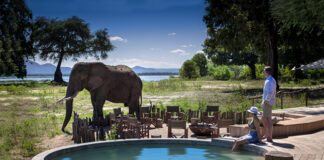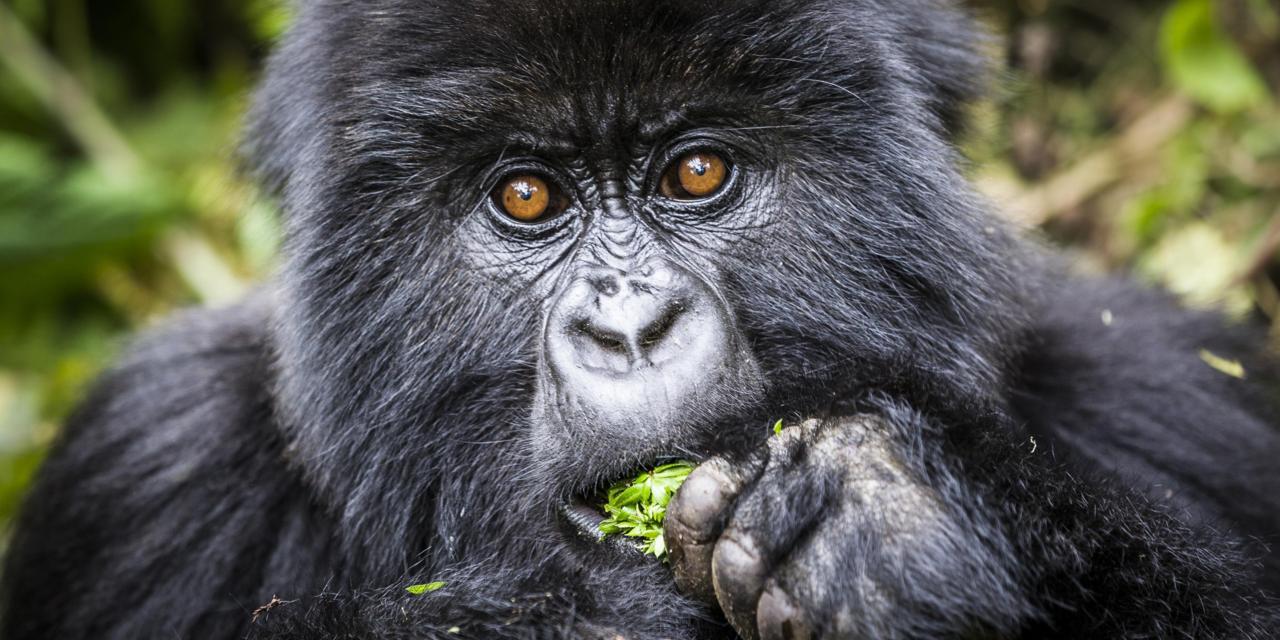Mountain Cameroon
It is the highest peak in sub-Saharan western and central Africa and the westernmost extension of a series of hills and mountains that form a natural boundary between northern Cameroon and Nigeria.
The Mount Cameroon Region offers an outstanding diversity of landscapes from tropical beaches with black volcanic sand, mangroves, swamps, agricultural landscapes, tropical and mountain rainforest to savannah and volcanic formations.
Mount Cameroon is one of Africa’s largest volcanoes, rising to 4,040 metres (13,255 ft) above the coast of west Cameroon. It rises from the coast through tropical rainforest to a bare summit which is cold, windy, and occasionally dusted with snow.
The massive steep-sided volcano of dominantly basaltic-to-trachybasaltic composition forms a volcanic horst constructed above a basement of Precambrian metamorphic rocks covered with Cretaceous to Quaternary sediments.
More than 100 small cinder cones, often fissure-controlled parallel to the long axis of the massive 1,400-cubic-kilometre (336 cu mi) volcano, occur on the flanks and surrounding lowlands.
A large satellitic peak, Etinde (also known as Little Mount Cameroon), is located on the southern flank near the coast. Mount Cameroon has the most frequent eruptions of any West African volcano.
Waza National Park
The Waza National Park located in the Far North Region, 120km from Maroua and 135 km of Kousseri, it contains, in addition to the lion, elephants, hyenas, hartebeest, roan and, of Buffon’s kob, waterbuck and reeds, gazelles, giraffes, and a large colony of birds: geese, egrets, ostriches, herons, pelicans, jabirus, ibis among others and covers an area of 170,000 hectares.
The climate is mostly semi-arid as the average annual precipitation is only 700 millimetres (28 in) and erratic in its incidence.
The rainy months are June to October and the dry season is from November to May, and can sometimes start as early as October.
vegetation types which cover the park are categorized under five broad types of open combretaceous shrub savannah, anogeissus leiocarpus woodland, lannea humilis open grass savannah, acacia seyal tree savannah and Yaéré floodplains with perennial grasses.
In the desert conditions, with no perennial streams flowing through the park area, there are no perennial grasses in the park. The water holes are created for animals. The combretaceous shrub savannah consist of Sclerocarya birrea tree savannah, Combretum and Terminalia shrubs and the doum palm Hyphaene thebaica.
The Anogeissus leiocarpus woodland is in sandy soils with Mitragyna inermis in pockets near temporary water bodies. Lannea humilis are open grass savannah combined with short annual grasses.
Patches of trees and stands of Mitragyna inermis are also reported from small islands near temporary water bodies.
The mammal population in the park is one of the largest in central West Africa. There are 30 species of mammals in the park.
Some of the species of interest from the conservation angle are the red-fronted gazelle (Gazella rufifrons), whose population is on the rise, and the korrigum (Damaliscus lunatus korrigum), which is stable.
The endangered African bush elephant, which feeds in the Vachellia seyal shrublands, creates conflicts even with farmers located far away.
Waza harbours a dwindling population of lions. A recent survey counted only 14–21 of these big cats. Waza is also home for one of the last populations of the Kordofan giraffe (G. c. antiquorum).
Kob antelope have increased to 5000 in the 1990s since a strong decline in the 1980s. Other large ungulates are warthog and roan. Ostriches have been recorded. Elephants congregate at Mare aux Elephants, a famous watering hole.
Other species noted are hartebeest, tsessebe, olive baboon, patas and vervet monkey, leopard, cheetah and nocturnal aardvark.
Korup National Park
The Korup National Park is located in the South-West Region, and is a forest reserve known throughout the world covering an area of 125,600 hectares. It is considered as one of the oldest and most beautiful tropical forests in the world.
Korup National Park is reputedly one of the richest lowland African forests in terms of faunal richness and diversity, especially for birds, reptiles, amphibians and butterflies.
Korup National Park is in the Southwest Province of Cameroon and extends over 1,260 km2 of mostly undisturbed primary forest. It is reputedly one of Africa’s oldest and richest tropical forests in terms of floral and faunal diversity.
It is the most accessible rainforest national park in Cameroon with basic lodging infrastructure and a large network of trails open to visitors.
The park is a popular bird watching destination and famous for primate viewing (including species such as the drill, Preuss’s red colobus, red-eared guenon and Nigeria chimpanzee).
Researchers from various disciplines have been conducting biological studies in Korup for over three decades, generating a wealth of information on rainforest ecosystems.
Korup has a pseudo-equatorial climate with two seasons instead of four: a pronounced dry season from December to February with average monthly rainfall less than 100 mm and an extended and intense rainy season approximately from May to October. The heaviest rainfalls are typically in August.
Korup National Park is one of the most accessible rainforest protected areas in Cameroon. Day hikes or multiple day trips can be organized from the town of Mundemba, by visiting the tourist informational office located at the center of the town.
Entrance in the park is only permitted with a local guide. There are fixed day, overnight, camping and guide/porter fees. There are three camp sites open to tourists, where visitors can arrange stay either at a tent (bring your own) or at one of the lodges (with basic wooden beds – windows have simple screening).
Each camp site is located near a stream which serves as source of cooking water (boil or filter to drink) and for refreshing baths. There are basic pit toilets.
Limbe Botanical Garden
The Limbe Botanic Garden was founded by a group of Germans under the Directorship of Paul Preus in 1892.
It served as a trials and acclimatisation centre for the introduction of exotic crop species such as coffee, cocoa, rubber, oil palm, banana, teak and sugar-cane for distribution within “Kamerun” and other German colonies.
Learn about wildlife and relax at Limbe Botanic Garden, a popular recreational area at the foot of Mount Cameroon. Spanning over 52 hectares (128 acres), the garden features several well-marked trails leading through abundant wildlife sorted and labelled as well as a small zoo with gorillas, red-eared guenons, Preuss monkeys, and chimps.
Created in 1892 by a group of German horticulturalists, the area originally served for the acclimatization of new plant species as well as an agricultural training center for Cameroonians; today it includes a variety of native orchids, aquatic plants, and Cameroonian wild fruits.
Informed local guides will provide detailed knowledge about every plant. Prepare to encounter some curious monkeys, and look for the century-old trees along the river.
Benedictine Museum of Mont-Febe
The Benedictine Museum of Mont-Febe is another popular Cameroon attraction. The museum houses several sculptures of animals, African men and African sceneries. It features a huge collection of Camerounese art.
Examine all sorts of peculiar items and works of art that portray the nation’s diverse culture at Benedictine Museum of Mont-Febe.
Part of a nearby monastery overlooking the city, the well-maintained venue has a total of four display rooms, surrounded by trimmed lawns and exotic decorative trees.
Once you enter, grab a catalogue to fully immerse yourself in the ethnographic museum’s mission, history, and exhibits. Inspect a variety of artifacts as you walk through the corridors, including unusual bronze and wooden statues, ivory pipes, and tribal masks. You can purchase a copy of the book-catalogue as a souvenir.
The Mvog-Betsi Zoo
The Mvog-Betsi Zoo is located in Yaoundé, Cameroon .There is a wide range of species at the zoo, including Agile Mangabey, Baboon, De Brazza’s Monkey, Drill, Grey-cheeked Mangabey, Mandrill, Tantalus Monkey, Patas Monkey, Putty-Nosed Monkey, Red-Capped Mangabey, Lion, big cats, reptiles, and birds of prey.
The Royal Palace of Foumban
The Royal Palace of Foumban is located in the town of Foumban is the North-East of the Western Regional capital city of Bafoussam in the Republic of Cameroon.
The Royal Palace of Foumban is currently inhabited by the sultan (King), who is the 19th ruler of the Bamoun dynasty which dates back from the 14th century in history.
The Palace was renovated and completed in 1917 after which the belongings of previous Sultans were arranged and kept for tourist attraction.
It contains Sultan’s museum and rich collection of traditional weapons. Foumban is centre of culture, where indigenous writing was invented and used.
Mile 6 Beach Limbe
This is a beach located in the Southwest province and lies along the coast of the South Atlantic Ocean, is renowned for its perfect surfing waves and far less crowded than other more popular surfing spots.








